Try to decipher the fragmented word on top. If not successful klick on the button with the dot on it to match the red shape with the fragments on top. Click the button > to see more examples.
Isolated outlines of fragments of letters are often not recognisable as part of a whole because these fragments are sometimes closed. By covering part of a foreground, the individual fragments can open and contain possible invisible continuations. Our brain reacts to concealed features in a completely general manner and reconstructs the partially covered features. Grouping creates foreground and background.
One of the main tasks in image processing is differentiating between figure and ground. Aside from being able to see stereoscopically, the brain provides search tools for various features to aid recognition. There are nerve cells in the visual cortex which react to concealment features, for example to T- effects and X-effects. T-effects have already played a role in explaining Spots 6 and 7, and X-effects were important in semi-transparency in the Appendix to Spot 1.

Observe the animation from various distances and try to read the gaps. You can screw up your eyes a little and thus see the image out of focus.

If the dark figures are not too small, they can be merged to form a background, whereupon the light gaps are suddenly transformed into figures. The concealment features necessary for this tilt process which are missing in this example are created as a safeguard by the brain, particularly in the case of blurred vision. The main thing is that perception occurs rapidly enough and that our conscious mind regularly receives suggestions for the construction of likely environments. Aside from concealment features, our brain reacts to other factors that characterise a body; the cortex contains neural cells that react to a maximum curvature and trigger the segmentation of an inferred body into single parts (see Rubin's vase-face image). Complete neural networks are responsible purely for the perception of a figure against its background.[3]

The block figures are especially striking due to their form. But as soon as the gaps are read as a figure, a word appears against a black ground.
The Gestalt psychologists of the 19th and 20th centuries were especially interested in this key issue, which led to the development of various theories. In the 21st century, the ever-increasing flood of knowledge from work in neurophysics seems to have overtaken the somewhat dogmatic approach ofthe traditional teachings of Gestalt.
One of the first psychologists to have been intensely concerned with figure and ground was Edgar Rubin from Denmark. The well-known vase-face image was named after him [1]. This ambiguous illusionary object must however have been around for a very long time. Rubin's vase-face image can be seen in a picture dating from 1795. There is a reproduction of it in Donald Hoffman's book, "Visual Intelligence." [2]
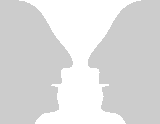
There are two possible interpretations; either the central area is perceived as the figure or it is relegated to the background to two symmetrically opposed facial profiles.
In the first case, the brain seeks concave areas with maximum curvature in the contours in the foreground with the help of specialised neural cells and breaks down the suspected grey figure in the centre into its constituent parts.
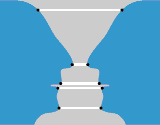
There must be whole networks in the brain which can join the parts of the figure which have been registered into a whole by means of newly created T-effects. Only then can the interpretation of the "vase" occur.
With the second way of viewing, the two faces form the figure and take the border for themselves (compare image 9 in appendix to Spot 1).
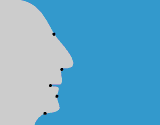
What is interesting is that the concave areas with the maximum curvature lie elsewhere. The segmentation into elements is completely different. If the second idea seems more plausible to the viewer, the old vase appears in the background again without form or contour.
The two can never be seen at the same time.
The left image is two dimensional with a line separating figure and ground. If the lower surface is meant to be a figure, the blue points are its boundary marks, in the other case it is the red points. Switching transforms concave areas into convex and vice versa.
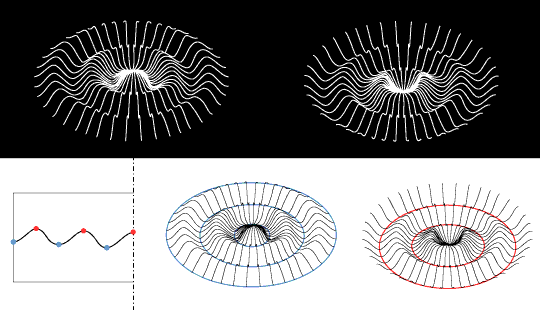
The axis with the dotted line is meant to be a rotational axis. The line of separation becomes an interface between a three dimensional figure and a three dimensional ground. The boundary points are transformed into separation lines between the parts of the three dimensional object. The centre image shows the figure formed from the lower surface; the blue separation lines lie in the valley floors. With enough imagination, one could imagine a baroque lampshade on a ceiling and thus swap figure and ground. With this interpretation, the separating lines are not drawn in properly. It is much easier to view the right-hand image to study the change between mass and space. Incidentally, this picture is identical to the centre picture, but when turned through 180 degrees. The right figure can also be perceived as an object on a ceiling with some effort. After a short time the brain automatically readjusts the image to the more familiar image above.
This unconscious behaviour must be linked to the fact that the eye level of the humanis relatively high. The two figures tilt momentarily when the image is turned through 180 degrees. (stand on your head or turn the screen upside down)
The next two pictures show two versions of the famous Schroeder stairs of 1854 [4] that we have adapted slightly. Both figures are completely symmetrical when swivelled so that they have the same interpretations are possible when they are seen from above or below in contrast to the original Schroeder stairs.
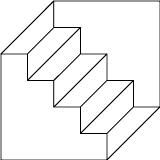
When briefly glimpsed, figure 8 can be interpreted as a staircase seen from below or above. A closer look in the case of the first interpretation seems to show that the side panelling of the staircase has been displaced, while the second presents a gross violation of the rules of perspective. The figure could also be interpreted as a bird's eye view of asculpture when two other interpretations are possible: either both sides of the staircase form a deep cavity and conceal the ends of three cylinders located deep down or they tower up towards the viewer enclosing a fan-pleated surface with the short edges pointing upwards. From experience the viewer would prefer to see the longer edges in the depth.
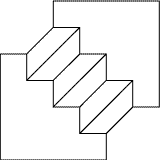
Figure 9 is a so-called "impossible figure". However, both interpretations would undeniably be plausible as sculptures. Our brains are constantly being put to the test when they attempt to perceive the external world. There is no such thing as an objective interpretation.
Geometric illusions of this boundary line change their significance when consciously switching figure and ground (blelb discovery).
Visual perception is an active selection process in which only the most plausible ofvarious competing potential images is allowed to appear. The most important of these then become the figure. The interpretation of figures benefits when the partial image
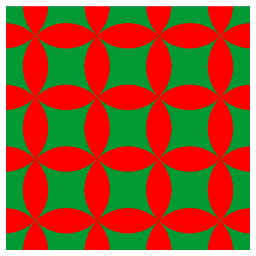
The plumped up redparts in figure 10 can be easily grouped to a figure in the foreground. The green parts on the other hand can only be perceived locally as figures. The dominant circular shaped delineations pull the red convex areas again to the foreground.
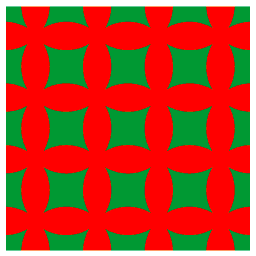
The green parts in figure 11 can be grouped together effortlessly to a whole. The red area is less stable as a figure and allows the green area to own the borders.
